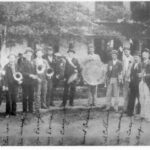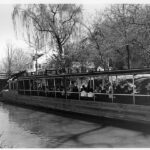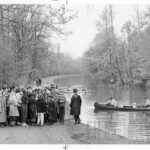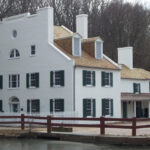Tourism Since the 1830s
By Ranger Aly
Boat:
As a park ranger based out of Great Falls, I watch visitors every day walk out to the falls, watch the mule-drawn canal boat pass through Lock 20, enjoy a picnic, and/or head out to the Billy Goat Trail. Great Falls is one of the most popular areas along the C&O Canal... and always has been. The Great Falls Tavern epitomizes this.
The very first locktender, W.W. Fenlon, realized he had a special location and a business opportunity. In 1830, he convinced the Board of Directors of the Canal Company to expand the original lockhouse and allow him to operate an inn. Patrons enjoyed a tasty home-cooked meal, dancing in the ballroom of the northern wing, and the fine hospitality of Lockkeeper and Innkeeper Fenlon.
For 25 cents, overnight guests could reserve a bunk in the ladies or the men's quarters on the second floor. The third floor attic served as "the honeymoon suite" and privacy could be secured for those with 50 cents and a marriage certificate.
Each day people would escape the hustle and bustle of the city by jumping aboard a packet boat in Georgetown and heading out to Great Falls. The trip would take 6-8 hours! These visitors would come to do exactly what they do today - walk out to the falls and hike the Billy Goat Trail. They would also visit the Tavern, called the Crommelin House, named in honor of a Dutch family instrumental in securing Dutch loans for the canal company. Some would spend the night, others would take a packet boat back to Georgetown, and still others would take the overnight boat ride to Harpers Ferry.
In the early 1900s, a trolley line operated by the Washington Railway and Electric Company opened up between Washington, DC, and Great Falls. This made getting to Great Falls much more convenient. Although it was discontinued in 1921, evidence of the rail line can still be seen in the Gold Mine Tract area.
Today, most folks take the short drive out to Great Falls where they still find a bit of natural wildness, an escape from the hustle and bustle of city life.
- Visitors of all types travelled up and down the canal to visit the Great Falls Tavern. Credit: Chesapeake & Ohio Canal National Historical Park
- Since the 1830s the Great Falls Tavern served as a destination spot for touristing Washingtonians. Credit: Chesapeake & Ohio Canal National Historical Park
- After the C & O Canal became a National Historical Park, the Great Falls Tavern hosted a different type of visitor. Canal enthusiasts, along with locals that had grown up with the canal, would visit and participate in canal boat programs. Credit: Chesapeake & Ohio Canal National Historical Park
- Interested groups of children and adults have enjoyed nature and history programs presented by National Park Service Rangers. Credit: Abbie Rowe, Chesapeake & Ohio Canal National Historical Park
- Great Falls Tavern Credit: CHOH NPS
- A birds eye view of the Great Falls Tavern during flooding. Credit: Chesapeake & Ohio Canal National Historical Park
- Bike along the canal and enjoy the spectacular views of the Mather Gorge. Credit: Chesapeake & Ohio Canal National Historical Park
- Enjoy a scenic walk through a bedrock forest on your way out to the Great Falls. Credit: Chesapeake & Ohio Canal National Historical Park
- This fish ladder was originally built to help the shad bypass the Great Falls. Today, it is one of the many smaller falls you walk over on your way to Great Falls. Credit: Chesapeake & Ohio Canal National Historical Park
- Mules are the engines of the canal boats and the heart of the park. Visitors are welcome to meet them. Credit: Chesapeake & Ohio Canal National Historical Park
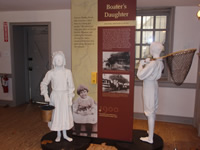
Great Falls Tavern Exhibits
Milepost 14.4

Mule-Drawn Canal Boat Ride
Milepost 14.4
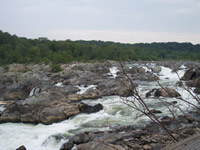
Great Falls
Milepost 14.1

